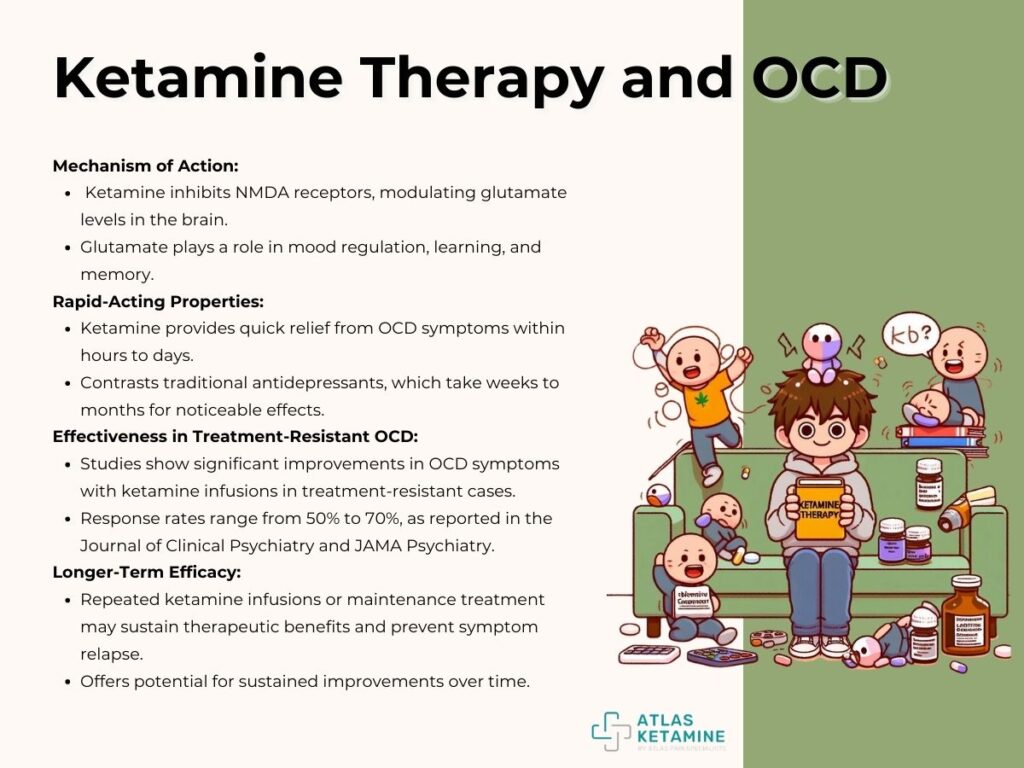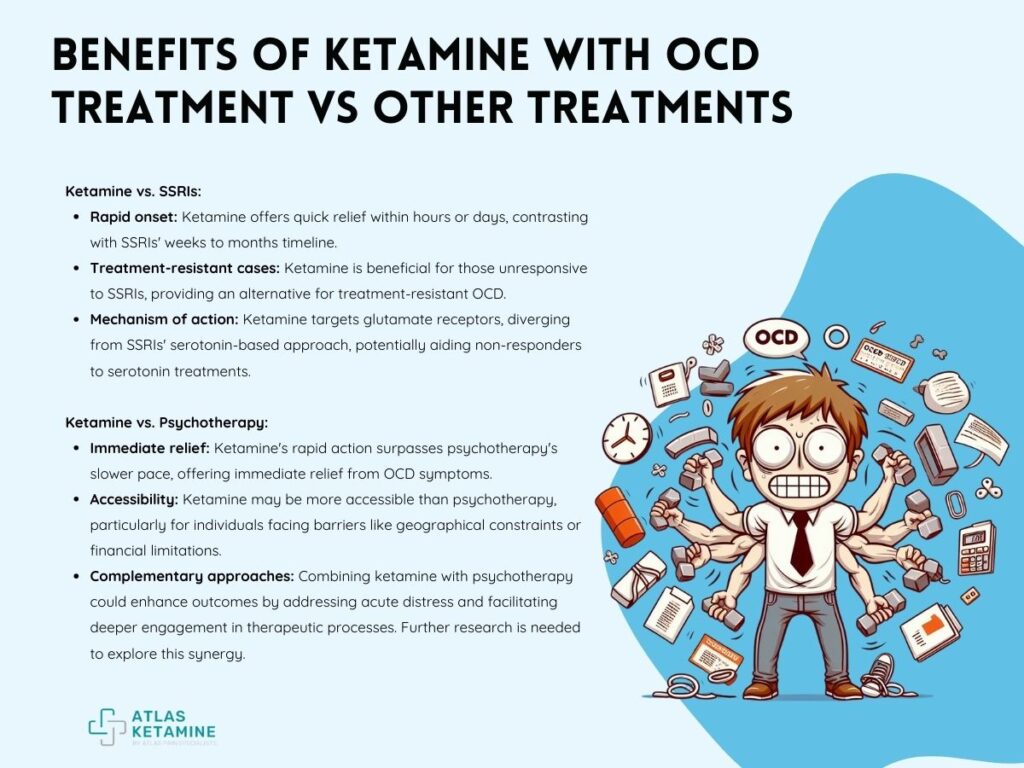Imagine feeling trapped in a cycle of intrusive thoughts and compulsive behaviors, unable to break free from their relentless grip. This is the reality for millions of people living with Obsessive-Compulsive Disorder (OCD), a mental health condition characterized by persistent, distressing obsessions and the urge to perform repetitive rituals.
In the ongoing pursuit of effective treatments for Obsessive-Compulsive Disorder (OCD), researchers are delving into unconventional paths, with one such avenue being the exploration of ketamine. Yes, you heard it correctly – ketamine, typically known for its recreational use or as an anesthetic in medical contexts, is now under investigation for its potential to mitigate the symptoms of OCD.
But how can a dissociative anesthetic like ketamine possibly help with a complex disorder like OCD? This blog will delve into Ketamine and Obsessive-Compulsive Disorder.
Obsessive-Compulsive Disorder (OCD)
Obsessive-Compulsive Disorder (OCD) is a mental health condition characterized by persistent, unwanted thoughts (obsessions) and repetitive behaviors or mental acts (compulsions) that an individual feels driven to perform in response to an obsession or according to rules that must be applied rigidly. These obsessions and compulsions significantly interfere with daily activities and cause considerable distress.
Individuals with OCD may realize that their obsessions are not grounded in reality and that their compulsive behaviors are unreasonable, yet feel unable to resist them without help.
The disorder spans a spectrum from mild to severe and can manifest differently in each person, making it a complex condition to understand and treat. Despite its challenges, effective treatments like cognitive-behavioral therapy and medication can help manage symptoms and improve quality of life.

We will now delve into the diverse manifestations of Obsessive-Compulsive Disorder (OCD), shedding light on its spectrum:
- Clinical OCD: This involves the classic presentation of obsessions (intrusive thoughts, fears) and compulsions (repetitive behaviors, rituals) that significantly interfere with daily life.
- Subclinical OCD: Individuals may exhibit obsessive or compulsive tendencies that don't meet the full criteria for diagnosis but still cause distress or impairment. This could include repetitive checking, counting, or arranging behaviors.
- Pure Obsessional OCD (Pure O): Characterized by intrusive, distressing thoughts or mental images without visible compulsions. Sufferers may engage in mental rituals to alleviate anxiety.
- Hoarding Disorder: Often considered a subtype of OCD, hoarding involves persistent difficulty discarding possessions, leading to clutter and difficulty functioning in living spaces.
The Need for Novel Treatment Options for OCD
Obsessive-Compulsive Disorder (OCD) affects millions worldwide, causing significant distress and impairment in daily functioning. While several treatment options exist, they often fall short of providing adequate relief for all individuals.
Here's a look at the limitations of current OCD treatments and the necessity for more effective solutions, with a focus on introducing ketamine as a novel approach based on research linking glutamatergic neurotransmission to OCD pathophysiology. Below are the limitations of current OCD treatments:
- Selective Serotonin Reuptake Inhibitors (SSRIs): SSRIs are the most commonly prescribed medications for OCD. However, many patients experience only partial symptom relief, and some do not respond at all.
- Cognitive Behavioral Therapy (CBT): CBT is a gold standard psychotherapy for OCD, but it requires significant time and resources. Access to qualified therapists may be limited, and not all patients respond adequately to CBT.
- Treatment-Resistant Cases: A substantial proportion of individuals with OCD do not achieve remission with existing treatments, leading to prolonged suffering and impaired quality of life.
- Side Effects: Both SSRIs and CBT can be associated with side effects such as nausea, insomnia, or sexual dysfunction, leading to treatment discontinuation in some cases.
The Necessity for More Effective Solutions
Despite advancements in the treatment of Obsessive-Compulsive Disorder (OCD), there remains a significant unmet need for therapies that provide rapid and robust relief from symptoms, particularly for cases resistant to conventional treatments.
The impact of OCD on quality of life is profound, influencing personal relationships, work performance, and general well-being. Effective interventions are vital to lessen the disorder's burden and enhance patients' functional capabilities.
The field of psychiatry also faces a shortfall in novel treatment options compared to other medical fields, highlighting an urgent need for innovative approaches to tackle the complexities of OCD and the challenges it presents in treatment. This gap underscores the importance of ongoing research and development in psychiatric treatments, aiming to offer new hope and improved outcomes for individuals struggling with OCD.
Introducing Ketamine as a Novel Approach
Recent research by the Yale OCD Research Clinic has highlighted the role of abnormalities in glutamatergic neurotransmission in the pathophysiology of Obsessive-Compulsive Disorder (OCD), pointing toward innovative treatment avenues.
Ketamine, known as an NMDA receptor antagonist, offers a unique approach by modulating glutamate levels in the brain, diverging from the mechanisms of traditional antidepressants. Its rapid-acting antidepressant effects, previously observed in treatment-resistant depression, present a promising potential for swiftly addressing the acute symptoms of OCD.
Preliminary studies into the use of ketamine for OCD treatment have yielded encouraging outcomes, with significant reductions in symptom severity noted after just a single infusion. These results suggest ketamine could represent a breakthrough in the treatment landscape of OCD.
However, the initial findings also underscore the necessity for more comprehensive research to fully understand the long-term efficacy and safety of ketamine in treating OCD. Further clinical trials involving larger participant groups and extended monitoring are crucial to confirm ketamine's therapeutic promise and to integrate it effectively into OCD treatment protocols.
Ketamine Therapy
Ketamine works by inhibiting the glutamate-mediated NMDA receptor in the brain. Glutamate is a neurotransmitter involved in various brain functions, including learning, memory, and mood regulation. By blocking NMDA receptors, ketamine modulates glutamate levels, leading to downstream effects on neuronal signaling pathways implicated in OCD pathophysiology.
Unlike traditional antidepressants, which may take weeks to months to produce noticeable effects, ketamine has demonstrated rapid-acting properties in alleviating OCD symptoms. Studies suggest that ketamine infusions can lead to significant reductions in OCD symptom severity within hours to days after administration, providing rapid relief for patients experiencing acute distress.

Effectiveness in Treatment-Resistant OCD
Research findings have shown the effectiveness of ketamine infusions in treating OCD patients who have not responded adequately to conventional therapies. A study published in the Journal of Clinical Psychiatry reported that ketamine infusions resulted in significant improvements in OCD symptoms in treatment-resistant patients, with response rates ranging from 50% to 70%.
Another study published in JAMA Psychiatry found that ketamine produced rapid and robust reductions in OCD symptom severity compared to placebo in individuals with treatment-resistant OCD.
Longer-Term Efficacy
While the rapid effects of ketamine are promising, studies also indicate the potential for sustained improvements in OCD symptoms over time. Research suggests that repeated ketamine infusions or maintenance treatment may help prolong the therapeutic benefits and prevent symptom relapse in individuals with treatment-resistant OCD. Below is a safety profile of Ketamine Therapy:
- Tolerability: Ketamine infusions are generally well-tolerated by patients with OCD. Unlike SSRIs, which may cause gastrointestinal disturbances, sexual dysfunction, and weight gain, ketamine infusions typically do not produce these side effects.
- Minimal Side Effects: Common side effects of ketamine, such as transient dissociation, dizziness, and changes in perception, are typically mild and short-lived. These side effects are usually manageable and resolve quickly after the infusion.
- Low Risk of Dependence: Ketamine has a low potential for dependence or addiction when administered in a clinical setting under medical supervision. Unlike some traditional medications, ketamine is not associated with withdrawal symptoms or tolerance development.
Benefits of Ketamine Compared to Traditional Treatments
In the realm of treating mental health disorders like OCD, the comparison between ketamine and traditional treatments such as SSRIs (selective serotonin reuptake inhibitors) and psychotherapy sheds light on potential benefits and differences in efficacy. Here's a breakdown:

Ketamine vs. SSRIs
- Rapid onset: Ketamine has shown promise in providing rapid relief from OCD symptoms, often within hours or days of administration, whereas SSRIs typically require weeks to months to achieve therapeutic effects.
- Treatment-resistant cases: Ketamine appears particularly beneficial for individuals who have not responded well to traditional SSRIs or other medications, offering an alternative for those with treatment-resistant OCD.
- Mechanism of action: While SSRIs primarily work by increasing serotonin levels in the brain, ketamine operates through a different pathway, targeting glutamate receptors. This distinct mechanism suggests ketamine may provide relief for individuals who do not respond adequately to serotonin-based treatments.
Ketamine vs. Psychotherapy
- Immediate relief: Ketamine's rapid-acting nature provides an advantage over traditional psychotherapy, which often requires weeks or months to observe significant improvements in OCD symptoms.
- Accessibility: Ketamine treatment may offer a more accessible option for individuals who face barriers to accessing psychotherapy, such as geographical limitations, cost, or time constraints.
- Complementary approaches: Some researchers suggest that combining ketamine treatment with psychotherapy could enhance outcomes, with ketamine potentially facilitating deeper engagement in therapeutic processes by alleviating acute distress and anxiety. However, further research is needed to explore the synergistic effects of this combination.
Conclusion
Ketamine offers a ray of hope for individuals grappling with the burden of Obsessive-Compulsive Disorder (OCD). While traditional treatments like SSRIs and therapy have been the mainstays, they don't always provide relief for everyone. Ketamine, with its unique mechanism of action and rapid onset of action, presents a promising alternative for those who haven't found relief elsewhere.
Although there are still challenges to overcome, such as refining dosing and ensuring long-term safety, the potential benefits of ketamine therapy for OCD are undeniable. With ongoing research and collaboration among scientists, clinicians, and pharmaceutical companies, we are moving closer to unlocking the full potential of ketamine as a game-changer in mental health treatment.
In the journey to alleviate the suffering caused by OCD, ketamine shines as a beacon of hope, offering new possibilities for a brighter, more fulfilling future for individuals living with this challenging condition.
